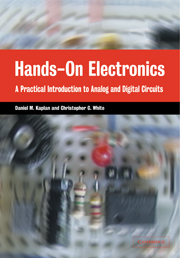Book contents
- Frontmatter
- Contents
- List of figures
- List of tables
- About the authors
- To the Reader
- Acknowledgments
- Introduction
- 1 Equipment familiarization: multimeter, breadboard, and oscilloscope
- 2 RC circuits
- 3 Diodes
- 4 Bipolar transistors
- 5 Transistors II: FETs
- 6 Transistors III: differential amplifier
- 7 Introduction to operational amplifiers
- 8 More op amp applications
- 9 Comparators and oscillators
- 10 Combinational logic
- 11 Flip-flops: saving a logic state
- 12 Monostables, counters, multiplexers, and RAM
- 13 Digital↔analog conversion
- Further reading
- Appendix A Equipment and supplies
- Appendix B Common abbreviations and circuit symbols
- Appendix C RC circuits: frequency-domain analysis
- Appendix D Pinouts
- Glossary of basic electrical and electronic terms
- Index
5 - Transistors II: FETs
Published online by Cambridge University Press: 06 July 2010
- Frontmatter
- Contents
- List of figures
- List of tables
- About the authors
- To the Reader
- Acknowledgments
- Introduction
- 1 Equipment familiarization: multimeter, breadboard, and oscilloscope
- 2 RC circuits
- 3 Diodes
- 4 Bipolar transistors
- 5 Transistors II: FETs
- 6 Transistors III: differential amplifier
- 7 Introduction to operational amplifiers
- 8 More op amp applications
- 9 Comparators and oscillators
- 10 Combinational logic
- 11 Flip-flops: saving a logic state
- 12 Monostables, counters, multiplexers, and RAM
- 13 Digital↔analog conversion
- Further reading
- Appendix A Equipment and supplies
- Appendix B Common abbreviations and circuit symbols
- Appendix C RC circuits: frequency-domain analysis
- Appendix D Pinouts
- Glossary of basic electrical and electronic terms
- Index
Summary
In this chapter we introduce the field-effect transistor (FET). A majority of today's integrated circuits are built using FETs of one type or another. FET operation is easier to explain than that of bipolar transistors; however, due to the variability of FET parameters, many people find FETs more difficult to use. As with bipolar technologies, it is essential that you master the basics of FET operation, and you will find that knowledge useful later on.
Apparatus required
Breadboard, oscilloscope, multimeter, two 2N5485 JFETs, one 1N4733 Zener diode, two 1 k, one 3.3 k, two 10 k, one 100 k, and one 1 M 14 Wresistors, 0.1μF ceramic capacitor, 1.0μF and 100μF electrolytic capacitors.
Field-effect transistors
Like bipolar junction transistors, field-effect transistors (FETs) are three terminal semiconductor devices capable of power gain. Qualitatively, they operate much like junction transistors, but they have much higher input impedance and lower transconductance and voltage gain. Also, they have a larger variation in their ‘VBE’ equivalent (called VGS) than bipolar transistors. They come in a confusing variety of types, but we will concentrate for today on junction FETs (JFETs).
Fundamentally, there are two types of FETs: junction FETs and metaloxide- semiconductor FETs (MOSFETs). In both types, a conducting channel between the drain and source terminals is controlled by a voltage applied to the gate terminal. The channel can be made of either N-type or P-type material (Fig. 5.1). N-channel is more common since the conductivity of N-type semiconductor (in which electrons carry the current) is higher than that of P-type (in which holes do).
- Type
- Chapter
- Information
- Hands-On ElectronicsA Practical Introduction to Analog and Digital Circuits, pp. 65 - 74Publisher: Cambridge University PressPrint publication year: 2003



